|
|
|
Assignment
3: Scenarios, Comparative Analysis,
and Initial Design
- Task
Scenarios
- Revised
Personas and Task Analysis
- Comparative
Analysis
- Initial Design
- Work
Distribution Table
Task Scenarios
Scenario
#1
James reads a news article,
then looks for industry trends and analysis.
|
While
sitting in his MBA class, James skims CNet’s
news website on his laptop. One story grabs his
attention: “Google takes ad service to China.”
He learns that Google will let advertisers in China
bid for keywords in traditional and simplified Chinese.
The article mentions that Sohu reported advertising
revenue of $9.5 million, a 120 percent rise from
last year. Figures and calculations race through
James' mind; he tries to extrapolate the current
market size and imagine how big it will grow over
the next five years. He is curious if there are
companies in China that specialize in Chinese character
search technology. He hopes he can find local partner
with whom he can work together to build a search
engine optimized for search Chinese characters.
He goes
to the Mapping China website where all the information—industry,
market, company, and contact data—is arranged
in a clear and easy to digest interface. He clicks
the industry analysis section where he read a brief
overview of the search engine market in China. He
goes on to select a specific company. The company
page contains a brief description of the company
and its management team. Suddenly, he remembers
meeting the company’s vice-president of marketing
at a trade show a few months ago. He gives the VP
a call to see if he can a better sense of more market
trends.
|
Scenario
#2
Stella researching for class
project
|
Stella needs to write a paper on wireless industry
in China. She knows something about the topic already,
but still, she would like to have a general overview
of the industry and some specific statistics. She
comes to our site, and immediately sees "wireless"
listed under "industries". She clicks on it, and
it takes her to the wireless industry home page,
where she is given several paragraphs about the
industry and tools for her to visualize the information.
She selects bar chart to show the overall growth
of the industry from 1990. Also listed there is
all the major players in the wireless industry sorted
by revenue. She noticed China Mobile has the most
revenue, so she clicks on the company names and
reads more financial data about the company. She
wants to know the number of wireless subscribers
in China. She clicks on "statistics", and found
the 2002 figure. She reads some latest news about
the industry, and she is interested in reading some
analyst reports. She goes to the "resource" section,
and saw a list of websites with both free and paid-subscriptions
where she can get more information. She clicks on
one of them and continues her research.
|
Scenario
#3
Janet wants to find company
and market information for job search
|
Janet
is a 27 year-old graduate student interested in
job or internship opportunities in China. Prior
to pursuing her Masters degree, she worked for several
years as a software programmer. She's therefore
very familiar with the software industry, although
not particular to China. She knows China is the
fastest growing market for high tech and, thanks
to WTO and IP regulations, has been growing its
software industry. Janet has some familiarity with
China, and has an idea of where the major cities
in China are located. She's interested in finding
jobs in Shanghai, which she has heard is the most
international and cosmopolitan Chinese city.
She
has heard about the MappingChina web site from a
friend of a friend and types in the URL in her browser.
After skimming general information on China, she
selects the software industry so she can filter
the information to only that regarding her industry.
She's surprised to see that the software industry
is actually most active in the Guanzhou region;
she notes that there are more software companies
and news stories centered around that region. She
skims through the Chinese government's recent policies
regarding software, including intellectual property
and high tech park initiatives. But because she's
still reticent about life under communist rule,
she decides she's still interested only in jobs
in Shanghai. She reads a few statistics about Shanghai
area, including cost of living and salaries. They're
much lower than what she's used to, but maybe it's
worth a shot. She's still young and China is where
the throngs are amassing (not to mention the dire
job situation back home, given the terrible economy).
Unsure
of what software companies are located in Shanghai,
she zooms in on that province and does a company
search. She clicks through a few company summaries
for both Chinese companies and multinationals, and
even continues on to some of the company Web sites,
where she applies for a few of the openings on their
job pages. UTStarcom is a telecommunications company
that also delves in software. However, their closest
offices to Shanghai are in Hangzhou. She wonders
how far Hangzhou is from Shanghai? Could she live
in Shanghai and commute to Hangzhou? She zooms in
on the map to see the distances and looks up transportation
information for Shanghai. She notes that there's
a regularly scheduled train that goes between Hangzhou
and Shanghai, but it takes 2 hours to get between
the cities.
Taking
a break from this job search tactic, she clicks
on news to see which software companies are making
headlines in China. She clicks on a few news headlines
to read the articles that interest her, including
a few on software outsourcing to China -- evidence
that business is booming, but also that she'll have
some strong local competition. Eventually, Janet
decides to sign up with MappingChina in order to
regularly receive email headlines for the software
industry.
Finally,
she clicks on the Guanxi link to see what software
professional groups and events might lead her to
company contacts to assist in her job search. She
notes a couple that are active in her area (San
Francisco Bay Area) and decides to attend the next
meeting of the Chinese Software Professionals Association.
According to the CSPA Website, they will be welcoming
a speaker soon who will talk about his entrepreneurial
experiences setting up a software startup in China.
|
Scenario
#4
James
looking for possible competitors and partners
|
James
has been chewing over an idea for a new start-up
company that would serve as a liaison between semiconductor
design firms in the U.S. and fabrication firms in
China. He wants to find out if any other companies
are already providing this service and, if so, whether
they would be potential partners or competitors.
He decides to try out a new web portal developed
by some SIMS students. He settles at his computer
after dinner one night to do the initial research.
He brings
up the web portal and browses companies in the semiconductor
industry, seeing that they’re mostly located
in Shanghai. This makes him curious about the development
of the industry in China over time, so he looks
at that. He then looks through current news stories
on the industry and on specific companies. For companies
that catch his interest, he looks up service type
(design house, fabricator, etc.), specialization
(consumer product chips, computers, servers), parent/subsidiary
relationships, statistical information – size,
financial data – and website link (if any)
for a company contact. After about an hour and a
half, James has found and printed out information
on a few companies that he will ask his colleagues
about at an upcoming conference on high-tech development
in Asia. Satisfied, he checks his email quickly
before logging out and going to bed.
|
|
Revised Personas and Task Analysis
We
added 1 more persona because our interviews indicated
that the main users would be business-savvy students and
professionals looking to get involved in the high tech
market in China. Therefore we conducted an extra exploratory
interview with an MBA student to verify that there is
a demand for the Mapping China tool among that demographic
group.
Persona
#4 James Kwong
30-year-old second-year male MBA student |
|
James
is an aspiring technology entrepreneur who is thoughtful
and directed. After receiving his bachelor’s
and master’s degrees in electrical engineering,
James worked as a computer chip designer before
moving over to product marketing and sales, where
he found his true calling. His goal after graduating
is to start his own business – he has many
ideas for high-tech services, applications, and
products that he would like to develop and market.
He is interested in the high-tech market in China
because that’s where the greatest opportunities
are taking place.
Although
he was born in Taiwan and speaks Taiwanese and some
Mandarin, James’ family moved to the United
States when he was very young, so he considers English
to be his native language. He feels most comfortable
and confident communicating in English for business
purposes. For this reason, he wants to interact
primarily with the U.S. affiliates of Chinese companies,
since GuanXi and speaking Chinese are essential
to doing business with Chinese companies.
When
he first got into marketing and sales, James attended
many networking events and conferences. Now that
he is more knowledgable about the field, he doesn’t
go to as many events, but his contact network is
still a primary source of industry information.
When James hears about a trend or wants to learn
more about a particular company, he will do some
basic internet research and then call up people
he knows to get more information. James wants to
know more about the smaller high-tech companies
in China as well as who they’re affiliated
with in the U.S. so that he can evaluate them for
partnerships or as competitors. He plans to live
and work in the U.S. but travel to China regularly.
James’
Goals
•
Understand the interrelationships among American
and Chinese companies
• Find out a particular company’s specialization
• See where industry concentrations are located
geographically in China
• Find out who the key players are in each
industry
• Get contact information for companies, both
American and Chinese
• Find out information on professional organizations
in China
• Use a China MapQuest to help |
|
Revised
task analysis:
|
|
|
|
|
| Task
Frequency |
Janet
Chen |
Stella
Ling |
James
Kwong |
Scott
McIntyre |
| Scan
for news about high-tech China |
|
|
|
|
| Skim
mainstream periodicals |
hi |
hi |
me |
me |
| Sign
up for targeted newsletters |
me |
me |
me |
hi |
| Read
discussion boards and weblogs |
hi |
lo |
lo |
lo |
| Research
specific industries and companies |
|
|
|
|
| Search
Google |
hi |
me |
me |
me |
| See
who key players are |
hi |
hi |
hi |
hi |
| See
relationships among companies |
me |
hi |
hi |
hi |
| See
where industries are located |
hi |
me |
hi |
hi |
| Get
company contact information |
hi |
lo |
hi |
hi |
| Get
stats from government websites |
me |
hi |
hi |
me |
| Read
market research reports |
me |
hi |
me |
me |
| Compare
news and analysis for reliability |
|
|
|
|
| Collect
data from multiple sources |
me |
hi |
hi |
hi |
| Ask
contacts in the field |
lo |
hi |
hi |
hi |
| Evaluate
credibility of source |
lo |
hi |
hi |
hi |
| Network
with industry insiders |
|
|
|
|
| Attend
trade shows/conferences |
lo |
hi |
me |
hi |
| Locate
trade associations |
lo |
hi |
hi |
hi |
| Find
travel information |
hi |
hi |
me |
lo |
|
|
|
|
|
Comparative Analysis
Competitor
#1
|
Telecomasia.net |
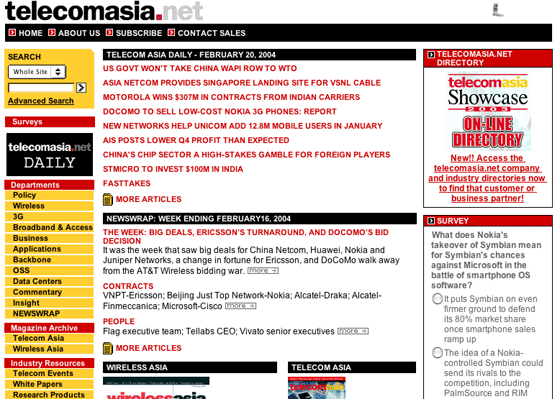
WHAT:
Telcomasia.net is an online news and research portal
catering to professionals in the telecommunications
industry in Asia.
DESCRIPTION:
A publishing company based in Hong Kong operates
this portal as an extension to its print business.
The portal consists of three main components: news
headlines, company and industry directories, and
research resources.
AUDIENCE
Telecommunications industry professionals
POSITIVES
- Overall the user interface is straightforward,
allowing users to skim news and get to analyst reports
with just a few clicks.
- Every page in the website has the same layout.
- The uniform layout allows users to focus on the
main content as they browse through the site.
- The menu is a visible and consistent navigation
element that effectively guides users as they move
from page to page.
NEGATIVES
- The left menu contains over 30 items divided by
categories headers
-
The company directory section is populated with
only barebones information.
- The user goes in expecting to find company descriptions,
statistics, and various other data, but telecomasia.net
does not provide such detailed information.
- Telecomasia.net relies on companies to input their
own data.
- The only way for a company to submit its data
is via a PDF form, which defeat the whole purpose
of web-based information exchange

The
research resources area breaks down the telecom
industry into a hierarchy of equipment and service
providers. The arrangement of these categories anticipates
what topics users will look for as they browse.
This directory serves as a reference for Mapping
China to breakdown the high-tech industry.
|
Competitor
#2
|
IDC
(International Data Corporation) |
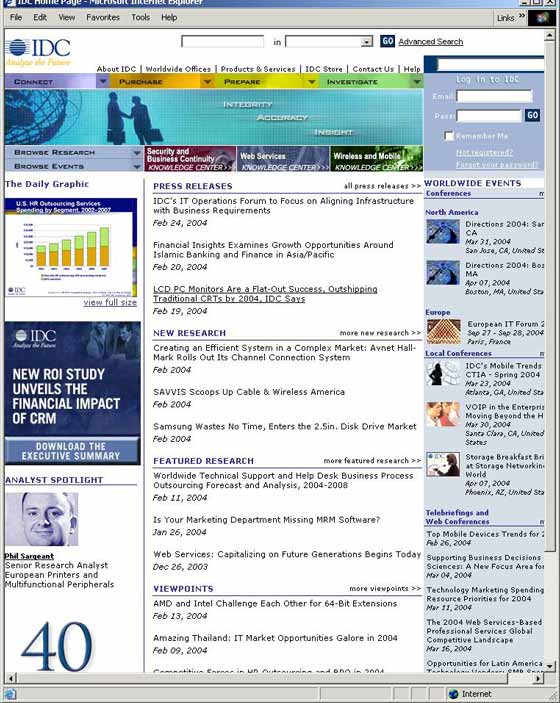
WHAT:
IDC (International Data Corporation) Market Analysis
for worldwide telco market
DESCRIPTION:
Industry-specific market analysis portal (Paid service)
http://www.idc.com/getdoc.jhtml?containerId=IDC_P595
AUDIENCE
- Primary: Marketing professionals (Account Managers,
business
development), industry professionals
User Objectives: track industry news, information,
activity
- Secondary: Other people interested in the telco
market
User Objectives: track industry news, information,
activity
PURPOSE
- repository for market analysis, industry research
- e-commerce site to purchase such research
- advertise IDC services (get new customers for
consulting, analyst briefings, etc.)
CONTENTS/FEATURES
- secure log-in view as well as browse view (can
view abstracts, search)
- Customizable views with user registration
- Free newsletter (with registration)
- IDC RSS feeds to user desktop
- Browse research (by business area, geo, strategy,
technology)
- Browse events (all upcoming, by region, by event
type)
- Content Management System (CMS): Upload/download
documents
- IT advisory Tools (SmartIndex to help set competitive
pricing,
SmartBuy for procurement, etc.)
- Benefits of registering spelled out clearly
- Help is available -- some is task based, with
a handful of screen
shots for part of it
- data/analysis objectivity disclaimer
- request for analyst briefing
- side bar for recent IDC press releases, for Featured
Research
- Quick link to request to quote IDC (Web-based
form)
- Contact IDC (including listing of brick-and-mortar
offices)
POSITIVES
- Purpose of the site is clearly stated on homepage
- Main functionality of site is intuitive on homepage:
personalization
"My IDC", Login, it's a paid service (shopping
cart), Subscription, How To (Create a Business Plan,
etc.) services,
- Credentials displayed up front (Meet the Experts,
analyst teams, etc.)
- Possible personalization of site, including remote
storage
(Bookcase), saved searches - Search tool with filter:
by document identifier, author, company, geo, event,
topic, language (English or Japanese)
- Search tool has sort feature (published date,
title)
- Advanced features available (e.g. advanced search)
- all documents are labelled with date and author
- documents have summaries (abstracts)
- printer-friendly format available
- document summaries and Table of Contents available,
even without user registration
- site index/site map
- Web forms "remember" content typed in
them if user navigates back and forth (even without
completing "submit") -- did they use cookies?
NEGATIVES
- User experience: random javascript components,
some of which don't work on some platforms (like
my Mac, Unix), also some text formatting problems,
ghosting of UI objects (remnants that stay long
after your mouse is no longer on the GUI object)
- Content: Some menu choices are abbreviated (unfinished);
redundant bits lead to unnecessarily text-heavy
pages
- Information Architecture: no clear flow of data;
many menus
distributed all over home page
- Terminology: what is a "Bookcase" ?
(never answered, but you need to be a registered
user to use it); Inconsistent naming scheme of IT
Advisory Tools, data formats
- (side bar) IDC press releases, Featured Research
titles are not
related to the Telecomms industry
- Help removes button bar: how to go back?
- Help has 2 lists of options (help topics, and
sub topics per each). But help topics are a mix
of feature and task
- Cannot resize help window (but you can scroll);
window chops off some Help Topic options
- Help doesn't cover many topics - is it comprehensive?
- RSS feeds non-intuitive (complex, non-intuitive
techie process -- for marketing people -- involving
XML, cutting and pasting URLs)
- It's not clear how to use the IT Advisory tools
(can you link to
them? Do you have to pay for them? Do you have to
pay for an IDC analyst to use them and then deliver
the results to you?) Two layers into the Tools page,
I still don't know...(You have to call them to set
up an appointment in order to find out more!)
- link to jobs at IDC -- seems inappropriate here
- seems a little slow (I don't know if this is general
network traffic
or specific to their site)
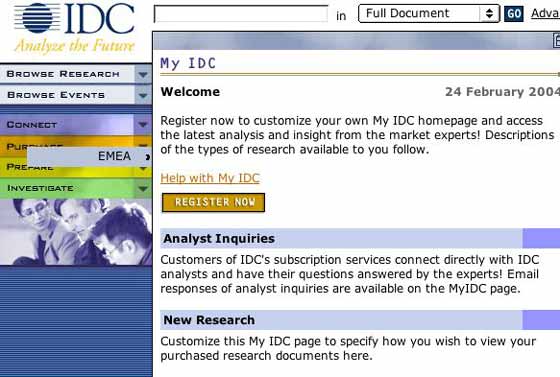
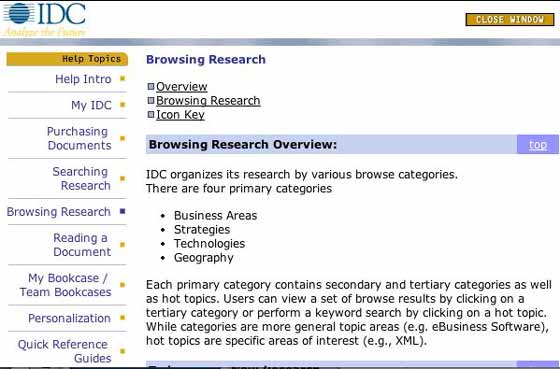
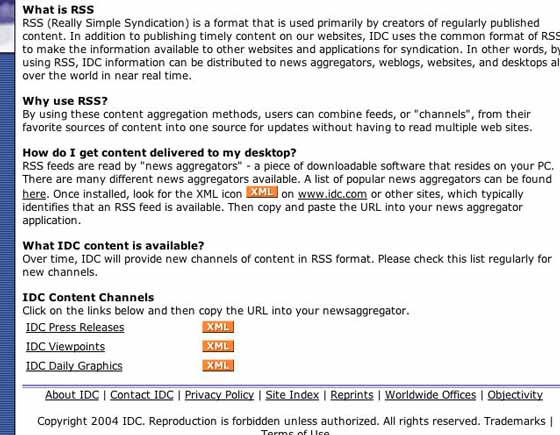
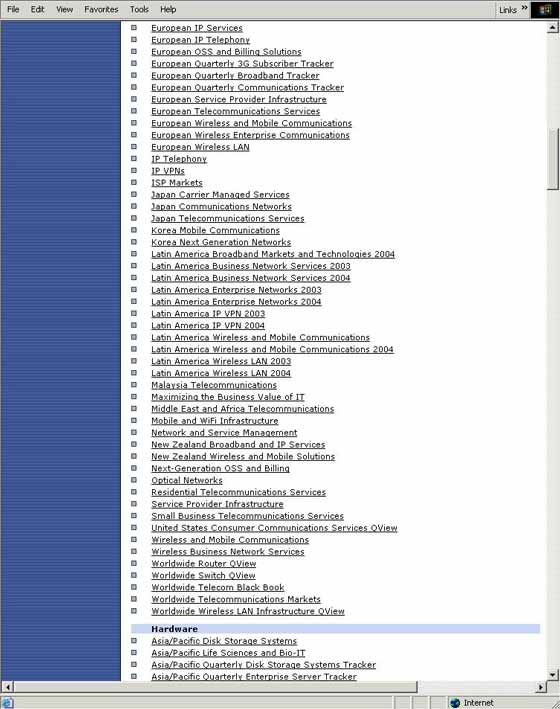
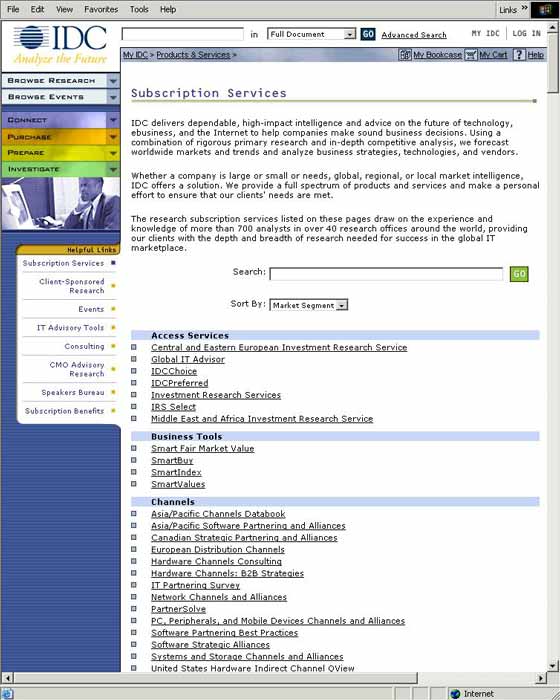
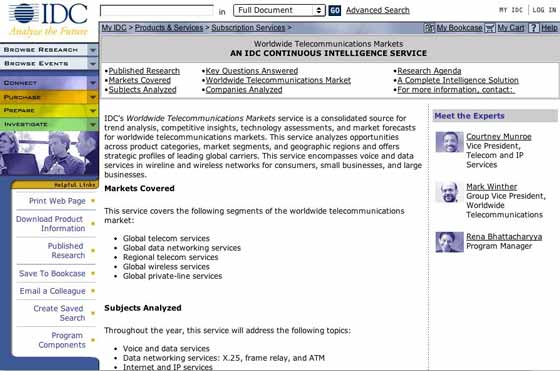
|
Competitor
#3
|
SmartMoney.com |
|
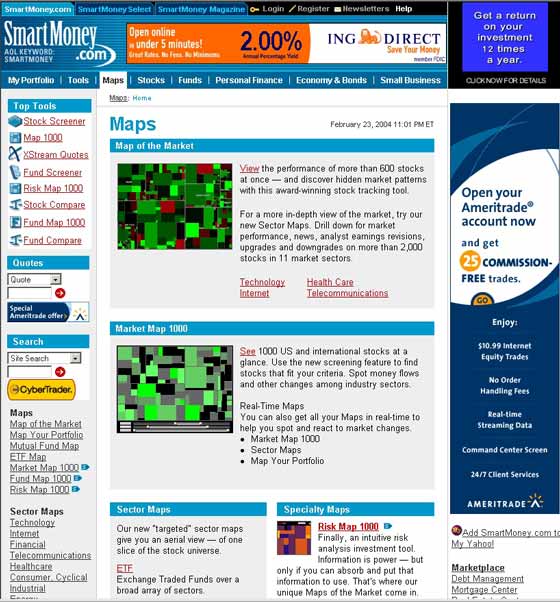
WHAT
SmartMoney.com Maps Feature (http://www.smartmoney.com/maps/?nav=DropTabs)
DESCRIPTION
Visualization tools and related information on company
and industry performance.
AUDIENCE
- Primary: Individual stock and mutual fund investors.
User objectives: see “hot” and “cool”
spots in industry, see current stock prices of companies
by industry, see size of companies in relation to
other companies in same industry, track company
performance over time, see who a company’s
competitors are, get recent news on companies and
industries.
PURPOSE
- Offer free and subscription-only investment information
services for U.S. and international companies
CONTENTS/FEATURES
- Visualization of companies and industries
- Visualization of companies within an industry
- News stories by company and industry
- Financial information on each company: stock price,
stock volumes and high/lows, graphs of performance
over time, earnings, ratings, competitors, key rates,
financials
- Free information on 600 stocks
- Subscription services for 1000 U.S. and international
stocks
- Mutual fund map
POSITIVES
- Visualizations very effective at depicting company
size and performance
- Easy to get a quick overview of industry performance
- A lot of good information on individual companies
- Icons in company boxes let users see which companies
have “news”
- Vertical hierarchy competitor graphs good way
to visualize performance relationships
- Site is customizable – users can track and
visualize their own stocks
- Maps are accessible for new users; by moving the
mouse around, users quickly see how the maps work
- “Find” function offers like names
when user begins typing a name
- “Find” search result consists of highlighting
relevant box on map and bringing up additional information
pop-up
NEGATIVES
- Must click through many screens to get information
- Screens come up as individual panes that must
then be closed; can’t use the “back”
button
- Company information is stock-oriented
- User must enter billing information before being
allowed a trial 2-week subscription
- Control panel for the map visualizations is separate
from the map; easy to lose it behind open panes
- Maps can be overwhelming at first sight –
one doesn’t have an immediate frame for using
them
- Information that could easily fit on one pane
is spread out over multiple panes (probably to allow
for advertising)
- Distracting animated ads and pop-ups
- News icon sometimes obliterates small companies
on the map
- “Find” search result highlight box
hard to distinguish from industry outlines
- Map discriminates against small companies, since
some are depicted as no larger than a dot
Main
map of all industries:
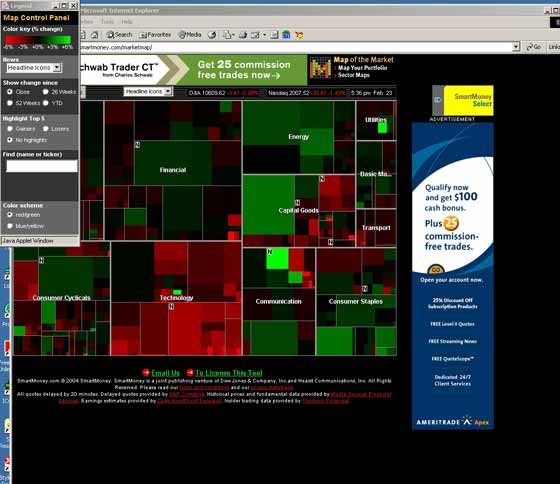
Company
information (Intel):
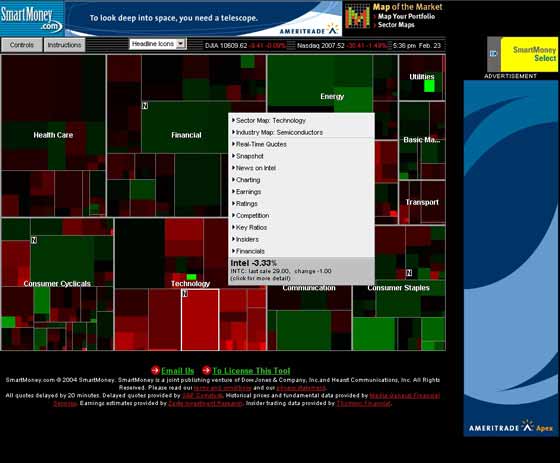
Competitive
analysis (Intel):
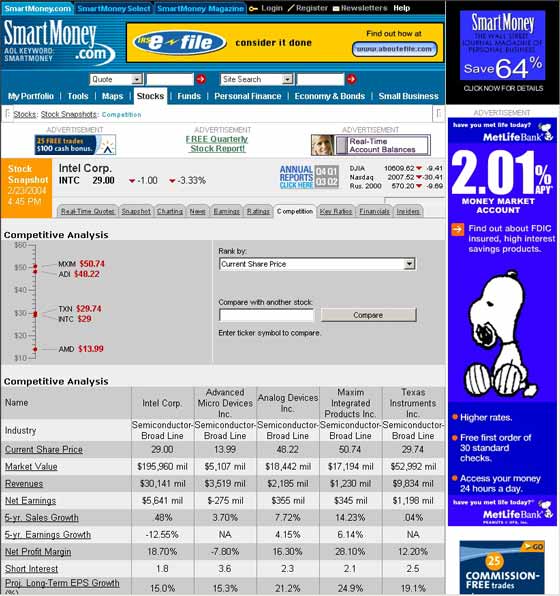
|
|
|
|